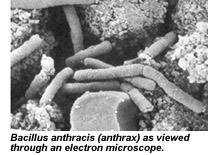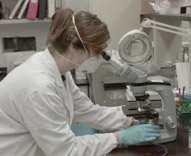

| << BACK |
Anthrax What is anthrax? Anthrax is an acute infectious disease caused by the spore-forming bacterium Bacillus anthracis. Anthrax most commonly occurs in wild and domestic animals like cattle, sheep, goats, camels and antelopes. It also can occur in humans when they are exposed to infected animals or tissue from infected animals, or following an intentional release of anthrax spores as an agent of biological war or terrorism. How common is anthrax and who can get it? Until the bioterrorism attacks in the U.S. in 2001, the last reported case of inhalation anthrax was in 1976; the last reported case of cutaneous anthrax, which is more common, occurred in 2000. Illinois’ most recent case was in 1960. Anthrax occurs in animals, most commonly in agricultural regions including Africa, Asia, the Caribbean, Central and South America, southern and eastern Europe, and the Middle East. Anthrax in livestock does occur infrequently in the United States. When anthrax affects humans, it is usually due to an occupational or recreational exposure to infected animals or their products. Workers who are exposed to dead animals and to animal products from other countries where anthrax is more common may become infected with Bacillus anthracis. How is anthrax transmitted? People were infected with anthrax during the 2001 bioterrorism attacks by inhaling thousands of airborne spores or by touching a powder form that was contained in letters delivered by the U.S. Postal Service. Inhalation anthrax occurs when the tiny spores are breathed in and settle in the lung, while cutaneous (skin) anthrax occurs when spores enter the body through minor cuts or abrasions on the skin. Humans also can become infected with anthrax by handling products from infected animals, by inhaling anthrax spores from contaminated animal products or by eating undercooked meat from infected animals. What are the symptoms of anthrax? Symptoms of disease vary depending on how the disease was contracted, but usually occur within seven days. Cutaneous. Most cases occur when the bacterium enters through a cut or abrasion on the skin. The infection develops one to 12 days after exposure and begins as a raised itchy bump that resembles an insect bite. Within one to two days, it becomes a fluid-filled blister and then a painless ulcer, usually 1 cm-3 cm in diameter, with a characteristic black, dying area in the center. Patients may have fever, malaise and headache, and lymph glands in the area near the ulcer may swell. About 20 percent of untreated cases result in death, although deaths are rare when antibiotic treatment is provided. Inhalation. This is the most lethal form of anthrax. While the incubation period in humans is unclear, it is believed to range from one to seven days, but possibly up to 60 days. Initial symptoms may resemble an influenza-like illness with sore throat, mild fever, muscle aches and fatigue. These symptoms may progress to severe breathing problems and shock, with meningitis frequently developing. After the onset of symptoms, inhalation anthrax is fatal in 75 percent of the cases, even with all possible care. Early antibiotic treatment increases chances for survival. Intestinal. The intestinal disease form of anthrax usually follows the consumption of raw or undercooked contaminated meat and has an incubation period of one to seven days. It is characterized by an acute inflammation of the intestinal tract. Initial signs of nausea, loss of appetite, vomiting and fever are followed by abdominal pain, vomiting of blood and severe, often bloody, diarrhea. It also can cause lesions at the base of the tongue, sore throat, difficulty swallowing, fever and swelling near lymph nodes. Death occurs in 25 percent to 60 percent of cases.  Is there a test to determine if I have been exposed to anthrax? There is no screening test for anthrax. There is no test a doctor can perform that says you have been exposed or carry the bacteria. The only way exposure can be determined is through a public health investigation. The tests that you hear or read about, such as nasal swabs and environmental tests, are not tests to determine whether an individual should be treated. These kinds of tests are used only to determine the extent of exposure in a given building or workplace. Can anthrax be spread from person to person? No. Anthrax is not contagious and cannot be transmitted from person to person. How is anthrax diagnosed? Anthrax is diagnosed by culturing Bacillus anthracis from blood, skin lesions or respiratory secretions or by measuring specific antibodies in the blood of persons with suspected cases. How can I detect the presence of anthrax? Bacillus anthracis spores do not have a characteristic appearance, smell or taste. Spores themselves are too small to be seen by the naked eye, but have been mixed with powder to transport them. Anthrax can only be identified through sophisticated laboratory testing. Is there a treatment for anthrax? Doctors can prescribe several antibiotics. To be effective, treatment should be initiated early. If left untreated, the disease can be fatal. When there has been a known bioterrorist exposure to B. anthracis, certain persons who had contact with the infectious material will be recommended for preventive treatment based on an individual risk assessment performed by public health officials. Determination of exposure will be made after police and public health investigative work and not by testing individuals. Results of nasal culture should not be used as a basis for prophylaxis. Positive nasal cultures confirm exposure but not the presence of disease. Negative cultures do not rule out exposure. Is there a way to prevent exposure? While it is not possible to totally eliminate the threat of a bioterrorism attack, the risk to the general public is low and can be further reduced by being alert for suspicious packages and by handwashing after opening the mail. Heightened public health surveillance continues so that anthrax cases can be promptly recognized and treated. Can you get anthrax from contaminated mail? As evidenced in 2001 in various cities on the East Coast, yes, it is possible and people should be alert for suspicious mail. Mail might be considered suspicious if it includes the following:
What should you do if you receive suspicious mail?
Persons at greater risk, such as a postal worker or mailroom clerk, should wear protective gloves and possibly a mask. Anyone who handles suspicious mail should thoroughly wash his/her hands. What is the anthrax vaccine? A vaccine has been developed for anthrax that protects against invasive disease, but it is currently only recommended for persons at high risk of exposure and is not available commercially. The vaccine has been mandated for U.S. military personnel between the ages of 18 and 65 (all are to be vaccinated by 2005). It is recommended for laboratory personnel who work directly with the organism and persons who handle imported animal hides and furs or potentially infected animal products in high incidence areas (not the U.S.). |